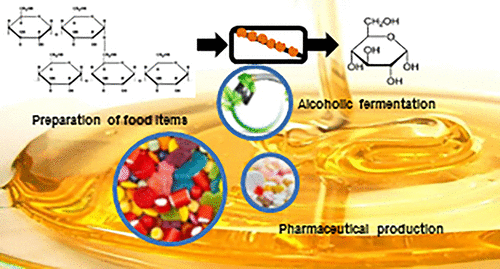当前位置:
X-MOL 学术
›
Ind. Eng. Chem. Res.
›
论文详情
Our official English website, www.x-mol.net, welcomes your
feedback! (Note: you will need to create a separate account there.)
Optimized Production of Glucose Syrup and Enzyme Membrane Reactor Using In Situ Product Recovery
Industrial & Engineering Chemistry Research ( IF 3.8 ) Pub Date : 2020-11-25 , DOI: 10.1021/acs.iecr.0c04636 K. A. Bueno-Zabala 1 , C. G. Lopresto 2 , V. Calabro 2 , S. Curcio 2 , A. A. Ruiz-Colorado 1 , S. Chakraborty 2
Industrial & Engineering Chemistry Research ( IF 3.8 ) Pub Date : 2020-11-25 , DOI: 10.1021/acs.iecr.0c04636 K. A. Bueno-Zabala 1 , C. G. Lopresto 2 , V. Calabro 2 , S. Curcio 2 , A. A. Ruiz-Colorado 1 , S. Chakraborty 2
Affiliation

|
Batch enzymatic hydrolysis processes require post-treatments to obtain a glucose syrup free of nonhydrolyzed materials and enzymes. An alternative process is the membrane process, which does not require the addition of chemicals. When membrane and enzymatic hydrolysis processes are combined, the resulting process is known as the in situ product recovery (ISPR) process. The present ISPR process studies focus on the efficiencies of enzymatic hydrolysis with continuous feeding of substrate and/or enzymes. However, little attention has been paid to the enzyme immobilization effect, which can be generated using membranes in conjunction with enzymatic hydrolysis during the production process. Temperature and pH affect the efficiency of glucose syrup production during the enzymatic hydrolysis and membrane processes. In this study, a response surface methodology is used to achieve maximum glucose syrup production without a continuous feed of substrate and/or enzymes. This study also focuses on the evaluation of the membranes as an enzyme membrane reactor. The membrane system operates with submerged membranes of hollow fiber in polyvinylidene fluoride with pure wheat starch in discontinuous diafiltration mode. Results indicated that the maximum glucose production is 73.6 ± 4.3 gglucose L–1 at 61.5 °C and pH 4.8. Besides, the fouling layer in the membranes act as a reactor. This reactor contributes to greater stability and resistance to sudden changes in operating variables. The reactor also has the potential to be reused, thus reducing costs associated with new membranes and enzymes.
中文翻译:

利用原位产物回收优化生产葡萄糖浆和酶膜反应器
间歇式酶水解过程需要进行后处理,以获得不含未水解物质和酶的葡萄糖浆。替代方法是膜方法,该膜方法不需要添加化学物质。当膜水解和酶促水解过程结合在一起时,所得过程称为原位产物回收(ISPR)过程。当前的ISPR工艺研究集中于连续加入底物和/或酶的酶促水解效率。然而,对酶固定作用的关注很少,在生产过程中使用膜结合酶促水解可以产生酶固定作用。温度和pH影响酶水解和膜工艺过程中葡萄糖浆的生产效率。在这个研究中,使用响应面方法可在不连续添加底物和/或酶的情况下实现最大程度的葡萄糖浆生产。这项研究还侧重于评估作为酶膜反应器的膜。该膜系统在不连续渗滤模式下将中空纤维浸入聚偏二氟乙烯中的膜与纯小麦淀粉一起使用。结果表明最大葡萄糖产量为73.6±4.3 g在61.5°C和pH 4.8下,葡萄糖L –1。此外,膜中的结垢层起反应器的作用。该反应堆有助于提高稳定性并抵抗运行变量的突然变化。该反应器还具有被重复使用的潜力,从而降低了与新膜和酶相关的成本。
更新日期:2020-12-09
中文翻译:

利用原位产物回收优化生产葡萄糖浆和酶膜反应器
间歇式酶水解过程需要进行后处理,以获得不含未水解物质和酶的葡萄糖浆。替代方法是膜方法,该膜方法不需要添加化学物质。当膜水解和酶促水解过程结合在一起时,所得过程称为原位产物回收(ISPR)过程。当前的ISPR工艺研究集中于连续加入底物和/或酶的酶促水解效率。然而,对酶固定作用的关注很少,在生产过程中使用膜结合酶促水解可以产生酶固定作用。温度和pH影响酶水解和膜工艺过程中葡萄糖浆的生产效率。在这个研究中,使用响应面方法可在不连续添加底物和/或酶的情况下实现最大程度的葡萄糖浆生产。这项研究还侧重于评估作为酶膜反应器的膜。该膜系统在不连续渗滤模式下将中空纤维浸入聚偏二氟乙烯中的膜与纯小麦淀粉一起使用。结果表明最大葡萄糖产量为73.6±4.3 g在61.5°C和pH 4.8下,葡萄糖L –1。此外,膜中的结垢层起反应器的作用。该反应堆有助于提高稳定性并抵抗运行变量的突然变化。该反应器还具有被重复使用的潜力,从而降低了与新膜和酶相关的成本。











































 京公网安备 11010802027423号
京公网安备 11010802027423号